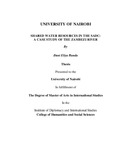| dc.description.abstract | On mainland SADC region, water resources of international river basins is the most shared natural resource among member states. Almost always, the water resources occur with varying abundance or scarcity at different times of the year, and in different parts of individual states and the region. These international river basins also cut across and between states with varying legal, political, economic and social situations, resulting in the existence of diverse rights over the utilisation of the shared water resources and potential for conflicts. The Zambezi river basin is largest of all international river basins in the SADC and most complex in terms of utilisation rights as the basin is shared in varying proportions by 8 riparian states. Compounding this complexity is the pursuit of divergent water development strategies among the riparian states and the diverse physical characteristic of the river basin itself. Realising that basin-wide cooperation premised on the principle of equitable and reasonable utilisation of the UN Watercourses Convention and SADC Watercourses Protocol is the solution to the complex problem of sustainably developing and equitably utilising the shared water resources, the 8 riparian states entered into the Zambezi watercourse agreement creating the Zambezi river basin regime. However, some riparian states are reluctant to be state parties to the agreement on the basis that their interests in the utilisation of the water resources of the Zambezi river basin are not well served by the principle of equitable and reasonable utilisation as drafted in the ZAMCOM agreement. Absence of basin-wide cooperation among the riparian states arising from the disagreement over the ZAMCOM agreement potentially weakens the river basin regime and suggests that the principle as drafted in the agreement may be contrary to the relevant provisions of the UN Watercourses Convention and SADC Watercourses Protocol. Therefore, this case study researched within framework treaty law of the UN Watercourses Convention and SADC Watercourses Protocol the drafting of the principle in the ZAMCOM agreement to uncover the lacunas causing disagreement and establish if the agreement and the creation of the Zambezi river basin regime are based on true interpretation of relevant provisions of international water law and SADC regional water law. Findings are that mainly due to its origins the ZAMCOM agreement is more of a framework agreement than a river basin agreement as it does not determine equitable rights for riparian states as required by Article 6 of the UN Watercourses Convention and Article 3(8)(a) of the SADC Watercourses Protocol, and precisely define the water resources under consideration in the agreement as provided by Article 3(4) of the UN Watercourses Convention and Article 6(4) of the SADC Watercourses Protocol. Conclusion is that the Zambezi river basin regime shall remain a weak and marginally functional river basin regime of no real utility in the management and development of the Zambezi river basin water resources unless the agreement is amended. Recommendation is made that the ZAMCOM agreement requires appropriate amendment, through rectifying the omissions in it and taking into account the unique factors and characteristics in the basin, if to transform the Zambezi river basin into a useful regime able to facilitate the equitable and reasonable utilisation of the water resources among all the Zambezi river basin riparian states.
Key words: agreement, basin, convention, equitable, international, principle, protocol, reasonable, regime, riparian, river, sovereignty, utilisation, watercourse | en_US |

